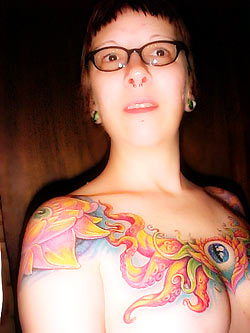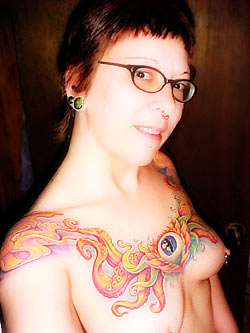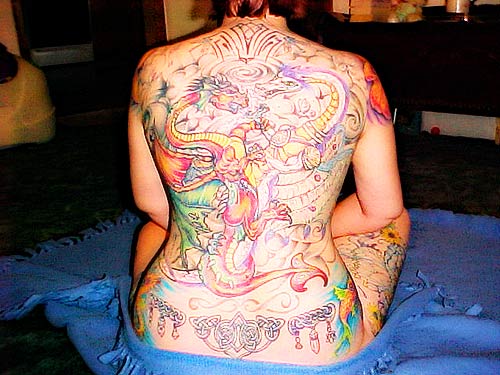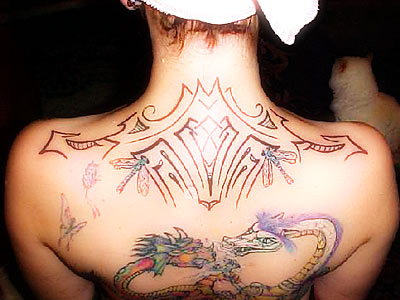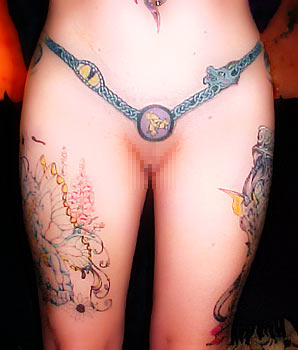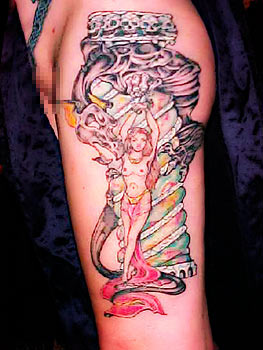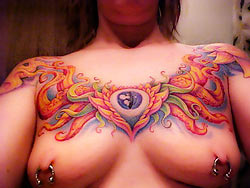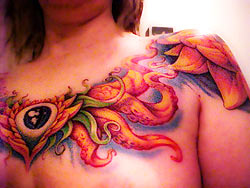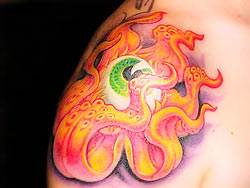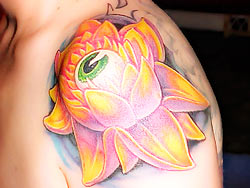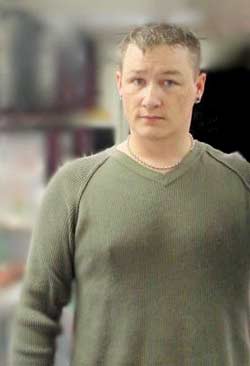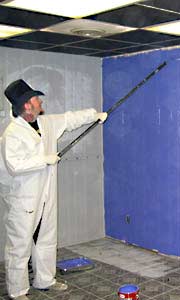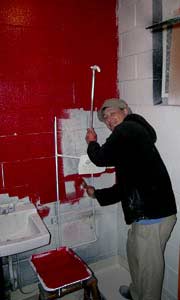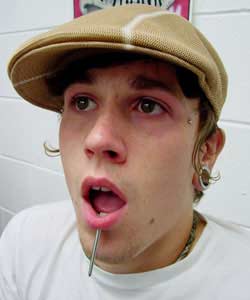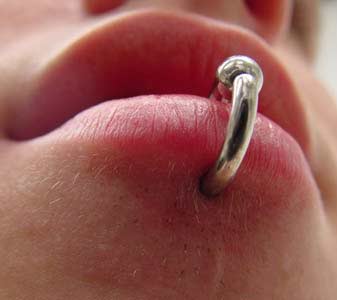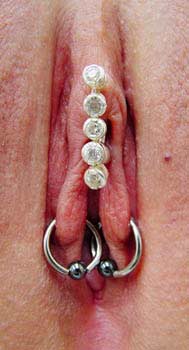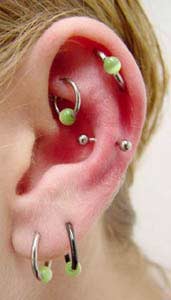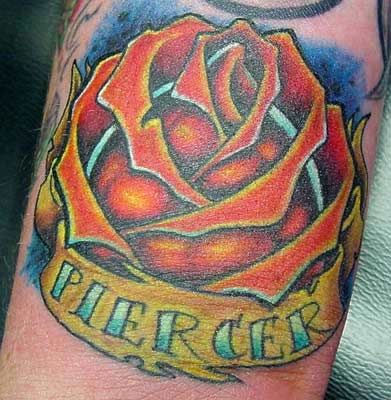|

Overdone v2.o:
Why Do People Get Wing Tattoos?
“There shall be wings! If the accomplishment be not for me, ’tis for some other.”
— Leonardo da Vinci
In late 2004, Shannon (IAM:glider) published an article on why people get star tattoos, allowing each person to explain why they made the decision to get stars. We know that there are a lot of other popular themed tattoos — butterflies, hearts, tribal designs, skulls, kanji, flowers, and cartoon characters are all widespread designs, peppered through different cultures, religions, and locations around the globe.
I wanted to explore why people get wings (most often) on their backs. Are they the type of people who’ve always longed to fly? Do they do it for religious or spiritual reasons — designed after the wings of an angel? Do they love nature and want to have the colours and design of a butterfly? No one will disagree that wings are a popular subject for tattoos, even Nicole Richie has wings… not that she’s the final say on things that are popular… by any means.
***
I spoke with the one of the first people to ever get full-back angel wings — if not the first — Elayne Angel, who got them in 1986 by Bob Roberts. She is renowned as one of the pioneers of professional body piercing in the United States and she founded Rings of Desire Inc. Body Piercing, in New Orleans, Louisiana in 1993. Angel served two terms on the Board of the Association of Professional Piercers (APP) and her wings are the first and only tattoo that’s ever held a registration from the U.S. Patent and Trademark office.
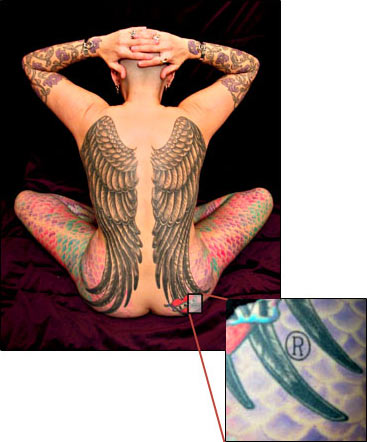
Elayne Angel’s Service Marked tattoo, and one of the first full-back wing tattoos in existence.
|
|
BME: |
A lot of people get tattoos inspired by other people’s work, but I don’t know of anyone getting a full-back wing tattoo before you, so where did the idea come from?
|
| ANGEL: |
Actually, from a t-shirt at a restaurant in Los Angeles! They were very abstracted wings though — with just a few lines and they were quite small. But the idea was planted and it grew from there. As soon as the concept occurred to me, I knew someday I would have angel wings even though I hadn’t ever gotten tattooed before.
In the early 80s, I had met a woman who had a beautiful full-back tattoo of a huge dragon. There were no flames, no water, no secondary design — just an enormous dragon. I hadn’t seen many heavily tattooed women, and certainly none with a large image like hers. I was captivated, and I decided I wanted a single-image, full-back piece of my own. I started to think about possible designs and when the idea came to me, I spent a year thinking about it (every day!) before I went ahead with it.
|
|
BME: |
What do your wings symbolize, and how did you decide on a style?
|
| ANGEL: |
I’ve always had flying dreams, which are the always the most fantastic dreams, and the wings tie into that. Also, it was about providing myself with a positive guiding influence. Wearing angel wings is an external manifestation of my desire to be a “good” person and it helped to develop my priorities, ethics, and behavior accordingly as I’ve matured. My wings are also a little bit dark and thorny, too, so they represent both sides of my nature.
What I asked Bob for was, “full size, detailed neo-classical black-work angel wings that cover my whole back.” I wanted them to conform to my body and enhance my curvy, feminine shape. I think Bob really came through for me with both requests.
|
|
BME: |
How long before you had them did you decide to service mark them?
|
| ANGEL: |
I’d had them over ten years by then, and it took about six years and numerous attempts to get the Registration approved. It was my attorney’s idea: he thought it would be a good idea on a business level because he felt that my wings were recognizable enough (in relation to me as a professional piercer) that protection was warranted, and I went along with it. At the time, he wasn’t sure it could be done because no human feature of any sort (including a tattoo) had ever been registered before. So it is a truly historical precedent and a positive step for body art to be recognizable as worthy of registration and legal protection like other forms of art.
|
|
BME: |
So, legally people are technically “allowed” to get wings like yours (but of course, you’d prefer them not to), but your wings cannot be used in any promotions without your permission — is that correct?
|
| ANGEL: |
Specifically, the legal protection afforded by the Registration is that my wings (or any wings that resemble them or could be mistaken for mine) may not be used to promote a piercing business or studio other than Rings of Desire.
|
|
BME: |
What do you think of people who copy your tattoo?
|
| ANGEL: |
I know imitation is supposed to be a form of flattery, but it honestly feels very strange to see my tattoo that I designed, on someone else. I know that other people have gotten their own original wings, too, which is totally cool, but I have tell you, I never thought that the wings tattoo thing would catch on the way it did. I’m pretty shocked really. Especially at the number of people who have brought my photo (of my personal, custom artwork) in to other studios to have “exact replicas” (or as close as the artist could get given their abilities or lack thereof). I never imagined anyone would do that, no less lots of someone’s…. I feel bad they’ve missed out on having a custom artwork of their own.
Original ideas and custom artwork are great, and there are lots of different winged creatures out there from which to derive inspiration. I guess as more people have more different styles of tattooed wings it will be harder to created original wings for your self. As long as someone is coming up with their own vision and it’s different from mine, I’m all for it.
|
***
So why get wings? Are people worried about any uniqueness being lost because of the popularity of wings? I spoke to several different people who allowed me to explore their tattoos with the hopes of teaching others that each person and tattoo is still unique, regardless of their popularity.
|
|
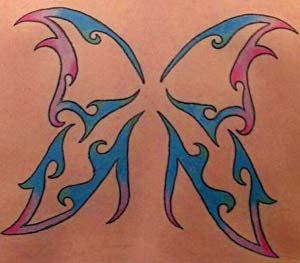 Kathryn is a 21 year old welder from Melbourne, Australia. She plays the cello and has been getting modified for the past four years. Kathryn is a 21 year old welder from Melbourne, Australia. She plays the cello and has been getting modified for the past four years.
I’ve always had a fascination with the human obsession with flying, which seems to have been going on for as long as we’ve kept any kind of written records. Da Vinci designed flying machines, we invent fairies for our children’s bedtime stories, the majority of our gods are considered to live in sky, and Greek myths and legends talk about Icarus and Hermes. Flying is considered the paramount and unobtainable freedom.
I designed my wings myself, and have always described them as “vaguely tribalish fairy-wings.” I think they’re unique, so it doesn’t bother me that other people have the same theme for a tattoo. I chose this specific design because I didn’t want anything particularly complicated that would make me spend hours in the chair, and I wanted a simple design so that when I’m older it doesn’t look awful.
I haven’t gotten any negative feedback from people on my wings, probably because those people who think they’re passé have had the good sense to keep their thoughts to themselves.
|
|
|
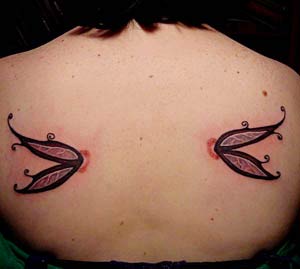 Désirée Fawn Kretschmar (IAM:givmewings) is a 19 year old from Peterborough, Ontario where she attends Trent University in their Cultural Studies program. She has a deathly fear of anything medical, like needles, doctors and nurses, and once she punched a nurse who was trying to take blood. That fear, however, does not enter into the body modification spectrum and she is comfortable with piercing and tattoo needles. Désirée Fawn Kretschmar (IAM:givmewings) is a 19 year old from Peterborough, Ontario where she attends Trent University in their Cultural Studies program. She has a deathly fear of anything medical, like needles, doctors and nurses, and once she punched a nurse who was trying to take blood. That fear, however, does not enter into the body modification spectrum and she is comfortable with piercing and tattoo needles.
I got my wings on August 1st 2004: the end of the summer, my last year of high school and in the next month my life was going to change. I’d be starting university, all my friends were going their separate ways and I was having a really hard time coping. My summer job was stressing me out to the point of tears every morning and night and I was going through relationship problems too. I decided I needed to quit being such a baby about all these problems, face the changes, and change myself. Earlier that year I’d gotten my labret done, and thought about getting another mod of some sort. However, piercings didn’t seem fulfilling enough, so I began thinking about tattoos. At the time, I thought I was going to cure pain with pain, and wings seemed the most appropriate symbol. I thought if someone gave me wings I could fly away and everything would be fine. Call it corny, call it cliché, call it whatever, but I call it freedom, expression. and it’s what I love.
A year or so before, I’d seen lots of pictures and read articles on BME about people with wing tattoos and I’d always found them gorgeous and fascinating. On the evening before my appointment, I sat up the entire night drawing out designs. I knew I didn’t want my tattoo to be picked off a wall, or out of a book, I wanted it to be completely my own creation. I finally came up with a simple design that I fell in love with.
After getting my tattoo, I was happy with the way they’d turned out, but a few months later I realized that they were done terribly, and I was really upset. They were uneven, the red shading was much brighter than I’d anticipated. I knew I needed to have them redone, so a little while later, I went with a friend who was getting a tattooed by a woman named Tammy. I was so impressed with her work that I got her to check out my back to see if she could salvage them. She ended up working on them, and now I have wings that I am truly proud of.
I had such a feeling of euphoria after having them worked on both times. They really helped me get through my year. I feel like my wings are a huge part of who I am right now. To me they are beautiful no matter what other people may think about them. They are also the most feminine thing about me apart from my anatomy. I’m a bit of a tomboy, my friends are 99% male, and I’ve always been considered “one of the guys.” For me, they let me express my femininity without being outwardly “girly’ which I loathe.
Some people have commented that they’re common and trendy, but c’mon guys! What mod is there that doesn’t go through some kind of “trendy’ stage? Everything is popular at one time or another, and I don’t think I was following any fads by getting my wings.
|
|
|
 Mike Johnson is a 45 year old self-described Aries/Rat who lives in Charlottesville, Virginia. By day he does layout and design work for a local newspaper, picking up freelance work when he can, from business cards to CD designs for local bands. By night he’s a drummer who plays in alternative, hard rock, punk, or gothic groups, depending on where his head is at the time. Mike Johnson is a 45 year old self-described Aries/Rat who lives in Charlottesville, Virginia. By day he does layout and design work for a local newspaper, picking up freelance work when he can, from business cards to CD designs for local bands. By night he’s a drummer who plays in alternative, hard rock, punk, or gothic groups, depending on where his head is at the time.
As an artist, the idea of using the body as a personal “canvas” had appealed to me for a while before getting my tattoo. It seemed that the problem I had was actually coming up with an image that I’d watn to keep for the rest of my life. Two things came together that make me decide I wanted a wing tattoo: I tend to be a “guardian angel” to the people around me, as I’m a very loyal friend — always there for people to talk to and rely on, and I saw an advertisement which featured a great photograph of tattooed wings (of the feathered variety). With that, I finally had the basis for a design. Plus, wings look better than a wearing a superhero cape! I worked with my tattoo artist, and we came up with the idea of “flaming wings.” I went with this idea because, to me, it signifies the image of a fallen angel (after all, I’m not a perfect angel, by any means). Even though wings are popular, I took a different approach than most, and we also went with bold as opposed to detailed to give the art more impact.
|
|
|
 Nicole is a preschool teacher from Orlando, Florida who’s been modified for the past five years. She says that road rage is her worst habit, and she strongly dislikes it when people watch her being tattooed. Nicole is a preschool teacher from Orlando, Florida who’s been modified for the past five years. She says that road rage is her worst habit, and she strongly dislikes it when people watch her being tattooed.
Originally, I thought wings were just a representation of something beautiful, but the longer I waited to get them done, the more they ended up meaning to me. I waited two years to get them, going from artist to artist, looking for someone who I could trust to do such a large piece. After the passing of both of my grandmothers, the tattoo turned into a tribute piece. It gave me peace of mind knowing they’d always have my back. As for the style I chose, I wanted something light and flowy. Harsh lines were out of the question from the beginning. My wings are similar to those of an angel — as style I liked because angels are delicate.
Knowing people are getting wings more and more, I can get frustrated. I think I hold my tattoo on such a high pedestal that seeing them get popular almost demeans their worth.
|
|
|
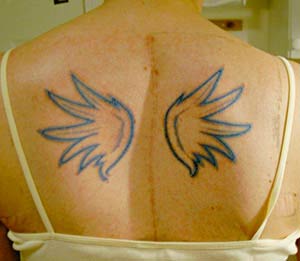 Jenn (IAM:osiri) is a 23 year old from Surrey, British Columbia. She works in a customer relations job, and is pagan. Jenn (IAM:osiri) is a 23 year old from Surrey, British Columbia. She works in a customer relations job, and is pagan.
In October of 2003, I had a full spinal surgery to correct a 67 degree curve in my back. Before the surgery I had been told that there was only a 24% chance I would ever walk again, so when I woke up in the recovery room, the first thing I did was ask the doctor how I’d done. He looked down at me and said, “Well, let’s put it this way — you certainly earned your wings.”
Strangely enough, even though my doctor’s words had stuck with me, I’d never seriously considered getting wings tattooed on myself. It was only when I was sketching aimlessly one day and came up with a design that I decided that I wanted to have as a tattoo. My drawing style is chiefly influenced by anime and manga designs, but the main reason why I chose my design was because I wanted something simplistic and almost childlike. My tattoo has a cartoon feel, which, to me at least, makes it fun and youthful. That was also the reason I chose to have it done in a teal-blue color rather than something darker — it was my way of making them a little more uplifting (pardon the pun).
I’ve always had a fascination with things with wings, and to me, having a pair was a way to sort of “fly away” from all the hardships and headaches caused by four years of abuse at the hands of an inept medical system. I’m pretty sure my doctor never thought he would plant the idea in my head, much less think it would stick while I was in a morphine induced vegetable-like state, but somehow it did — and as a result, I have the wings that I feel I rightfully earned.
|
|
|
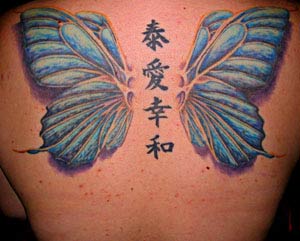 Marisa Terres is from Lompoc, California and is a 21 year old student. She’s interested in contortionism and wants to be able to sit on her own head someday. Marisa Terres is from Lompoc, California and is a 21 year old student. She’s interested in contortionism and wants to be able to sit on her own head someday.
I got my wings as a symbol of a new stage of life, where before I felt like I was a caterpillar hidden and held back. My parents had gotten divorced and I got to live with my father, which was something I was very happy about. My mother had always made all my decisions for me, and treated me like and inferior, but my father was opposite: he always has allowed me figure things out for myself. I ultimately went from a person who did everything that everyone else told me to do, to a person that thinks for herself and has self worth. It felt like I was set free and I could do anything I wanted to, even fly. When I had this opportunity to change and set my real self free, it was as though I had become a butterfly and changed into a more beautiful person.
I designed the tattoo myself, and wanted to keep the colour scheme as realistic as possible, so I looked for four months before deciding on butterfly wings. I had initially wanted a full, but small, butterfly, but the more I thought about it, I decided I wanted a set of wings for myself.
|
|
|
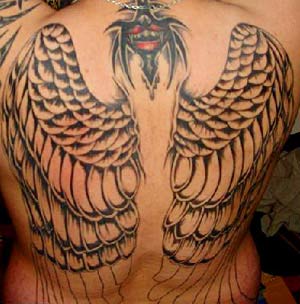 Pops (IAM:y2k_Pops) is a 22 year old man from London, England. He has given up a possible career in media production because he wants to get into piercing and tattooing. He says that because of his bands, body modifications and character, he’s drawn a following in his area. Pops (IAM:y2k_Pops) is a 22 year old man from London, England. He has given up a possible career in media production because he wants to get into piercing and tattooing. He says that because of his bands, body modifications and character, he’s drawn a following in his area.
I had wanted a tattoo which would cover most of my back and I went through a few ideas, making sure that what I chose would be meaningful. One of the ideas was the Colossi of Rameses, because I really like ancient Egyptian history and it would have looked really good, but in the end, the idea of wings won out.
I suppose on some level wings could signify the presence of escapism in someone’s psyche, but in my case I see wings as a symbol of beauty and the beast. Wingscarry a certain amount of poetic beauty, but there is also raw power and something otherworldly about a physical appendage that can defy gravity. To me, it’s a combination of a gentle (angelic) beauty and unnatural (demonic) physical power which defies natural law.
The shape and form of my wings a traditional style: they look like the wings of a large bird or angel. They’re not completed yet, but when they are finished, they will have tribal style tattoos on each feather and smoky shading around them, to compliment the vampire mouth I have on the top of my spine. All of my tattoos follow a kind of demonic or vampirism style. I have a few designs that I did for my legs that are a bit different from demons and vampires, but they are all a bit “dark” and somewhat gothic. It’s not that I am a massive vampire fan, but I do like the ethos of so called “demonic” beliefs like sex, sensuality, darkness of character and so forth.
Most of the responses from people upon seeing my tattoo have been about the pain I must have endured while getting it. I haven’t actually had a negative comment yet. As for the popularity of the theme, I don’t really care about it. I hadn’t even thought about other people’s wing tattoos until I booked the appointment with my tattoo artist. After that, I went through the BME and a few tattoo magazines to find other wing tattoos and it was at that point that I truly realized how popular wings are.
I just hope these wings will carry the memory of me becoming a piercer and tattooist: spreading my metaphorical wings and committing my life to a career I have always wanted.
|
|
|
 Emily (IAM:XxdoodlexX) is from DeKalb, Illinois where she works at a Podiatry center as a doctor’s assistant and secretary. She gets her modifications because she likes to be noticed. Emily (IAM:XxdoodlexX) is from DeKalb, Illinois where she works at a Podiatry center as a doctor’s assistant and secretary. She gets her modifications because she likes to be noticed.
Although I’m not a very religious person, I’ve always wanted a spiritual tattoo. After looking around BME for tattoo ideas, I went to my tattoo artist and we worked together on the idea of wings. I was dismayed at first, because all of the drawings I had showed unrealistic looking wings, and I knew I didn’t want a butterfly or fairy design. When he came up with an angel wing concept, I was really excited because they were so different than anything I’d seen before. I have never seen another pair of wings that look like mine, and that’s what I wanted. My tattoo symbolizes my belief that there is always an angel with me, and in some ways, I am even an angel.
When people see my tattoo, they say the expected stuff like, “What are you going to do when you are older?” “Why would you want something like that permanently on your body?” I tell them that if thought I’d end up being ashamed of them I wouldn’t have gotten them in the first place. I have no regrets, and they have significant meaning to me.
On the other hand, sometimes the popularity of wing tattoos bothers me. I think some people are just getting them just because they think it looks cool. Angel wings are very spiritual and symbolic, and should have a meaning or purpose behind them.
|
|
|
 Sandra O’Conner (IAM:Sandron) is a 19 year old who comes from Irish and Malaysian roots. She’s been all over the world because her father works for a large oil company. She has lived in The Netherlands, Malaysia, Singapore, and the Philippians, and she’s currently studying in Sydney, Australia. Sandra O’Conner (IAM:Sandron) is a 19 year old who comes from Irish and Malaysian roots. She’s been all over the world because her father works for a large oil company. She has lived in The Netherlands, Malaysia, Singapore, and the Philippians, and she’s currently studying in Sydney, Australia.
The initial reason for getting this specific tattoo was the result of being expelled from boarding school in Singapore. I’d gotten in trouble at school many times, and when they did a drug test on me, the results proved positive for MDMA. I was then told that it’d be best if I left the school, so I packed up all of my stuff, and the next day I was on a plane to the Philippines where my family was living.
I worked really hard at school in the Philippines, graduated high school with an IB degree, and was then accepted into a university in Australia. The wings stem from my life as a traveler — I hope someday I’ll be able to make a permanent home somewhere, and the wings are there as a memo that I’m looking for the place I’ll be able to call home. They’re also reminiscent of the places I’ve lived, the countless cultures that have influenced me (being in international schools my whole life, I’ve been exposed to a myriad of cultures and nationalities), and at the same time they represent my urge to continue travelling.
My wings are designed with Celtic knots in them, so as to match one of my previous tattoos. Being half Irish and never having lived there, it was one of those desperate attempts to grasp onto whatever culture I thought I was entitled to. I don’t mind that my tattoo is a popular theme, because they’re versatile to so many different emotions and inclinations — each set of wings on each person is going to mean something different to each person wearing them.
|
|
Each one of these people has a different motivation for getting their wings, so if you see them, or anyone bearing this type of tattoo, don’t automatically regard them as trendy; they chose that design because it’s a symbol for an important belief or event in their lives, and wings are a beautiful way to express these things. If you don’t like their tattoo, look past the it and into the reason behind getting it. If you’re considering getting your own set of wings, I ask one thing of you: make your design unique. No one likes to spend time, energy and money working on a one-of-a-kind tattoo for it to be ultimately copied and lose that quality. Imitation is not a form of flattery when it comes to tattoos — it’s an insult.
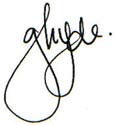
– Gillian Hyde (IAM:typealice)
|
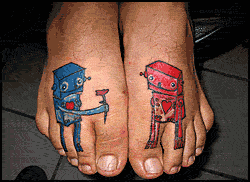
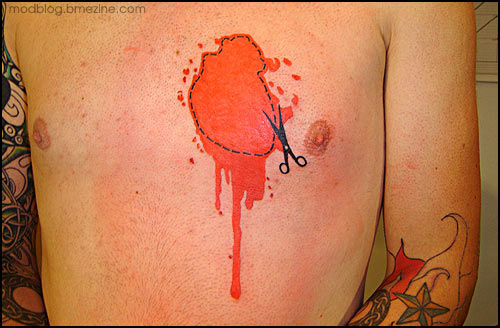
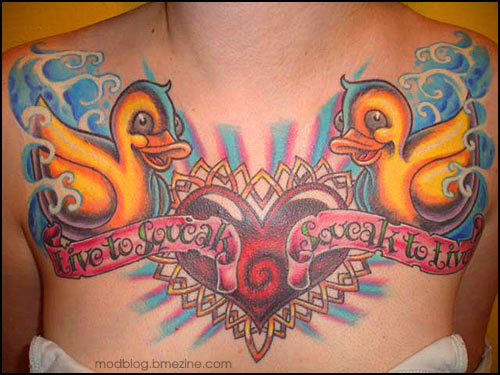
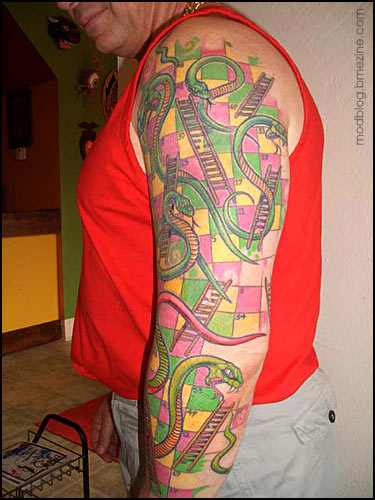
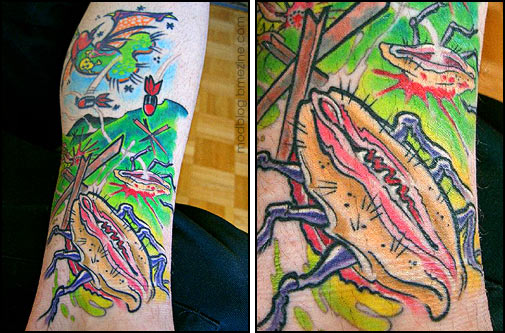
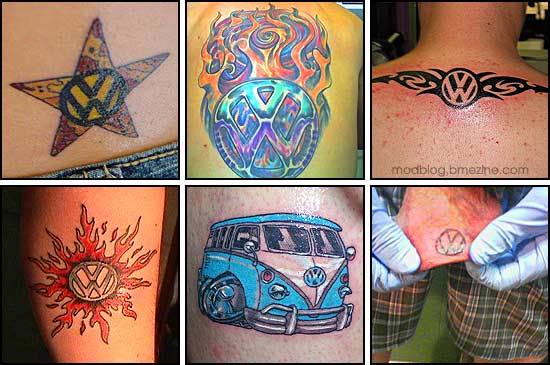
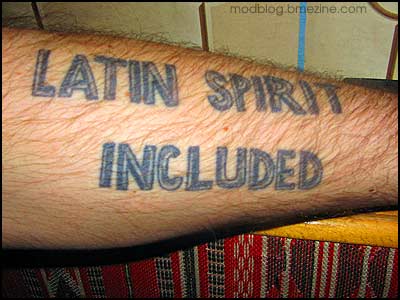


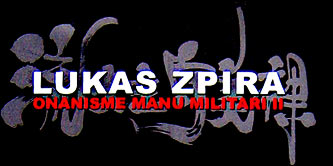
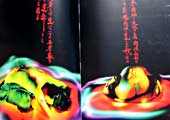

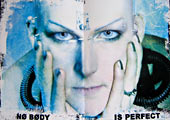
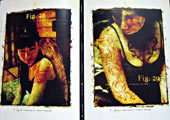
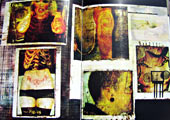
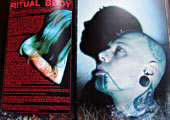
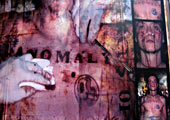

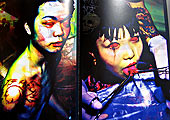

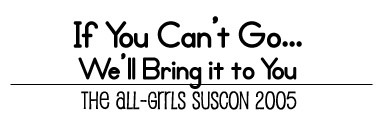






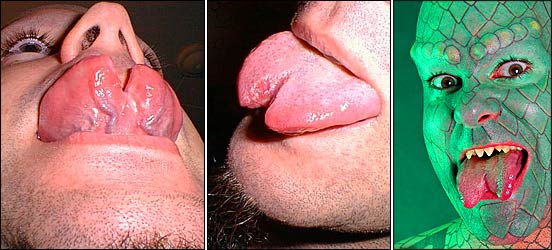

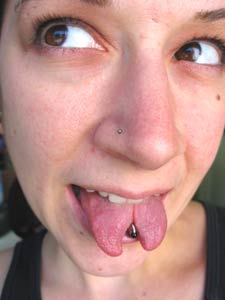
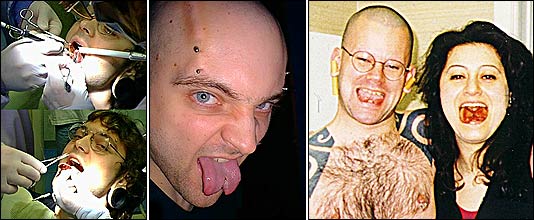

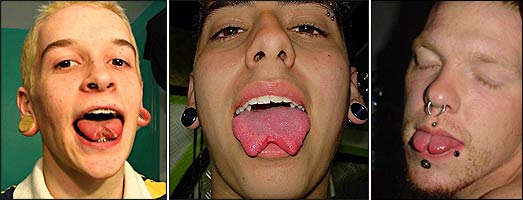
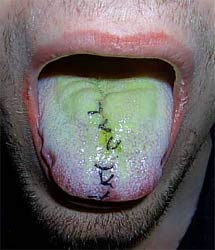


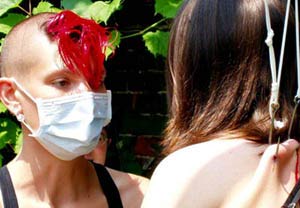
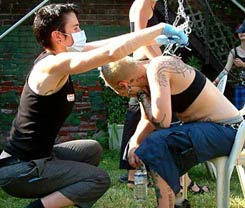
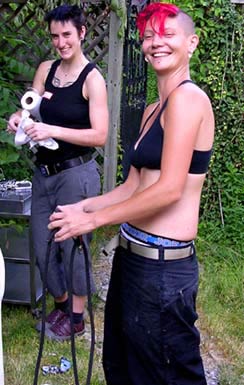
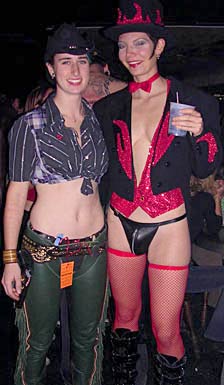
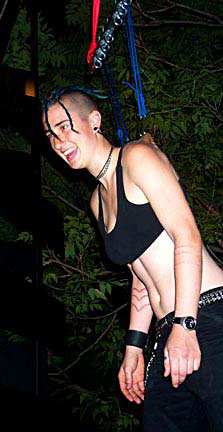
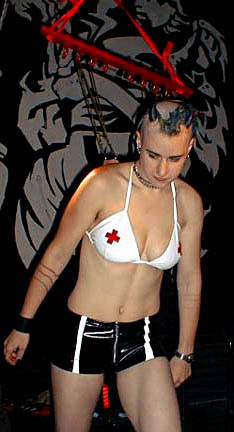
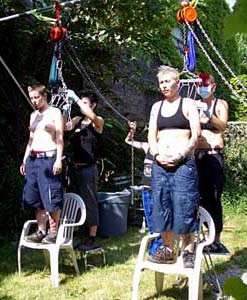
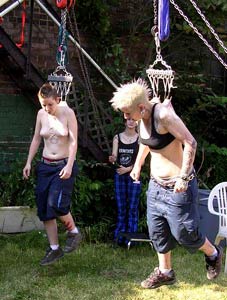
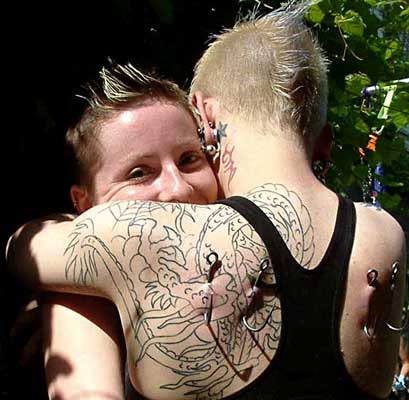
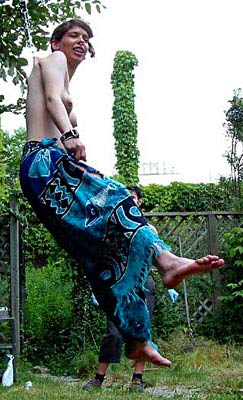

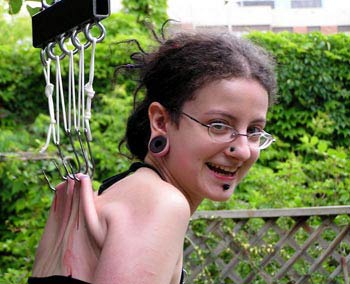
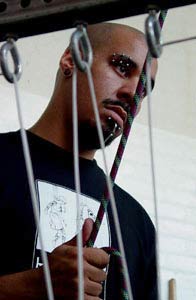
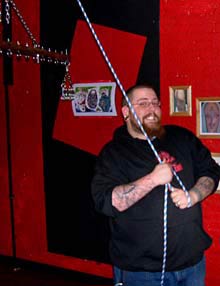

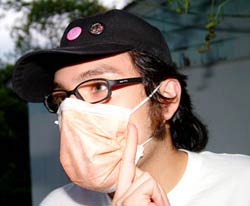
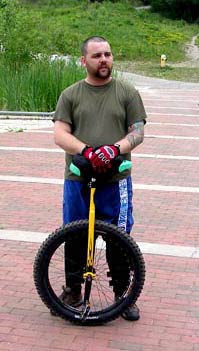
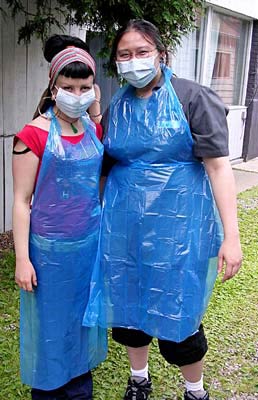
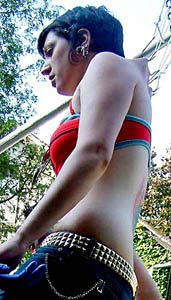
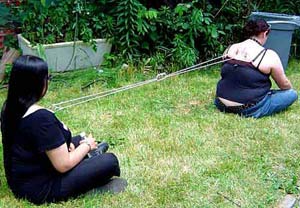

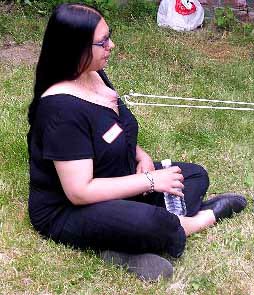
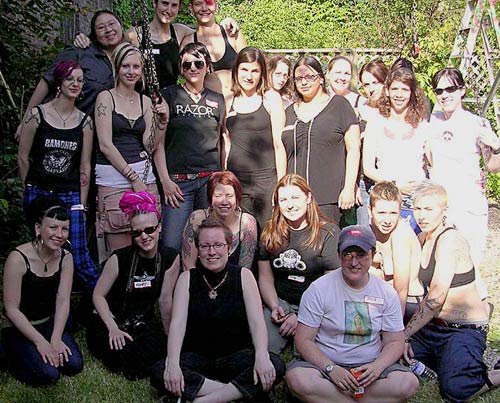

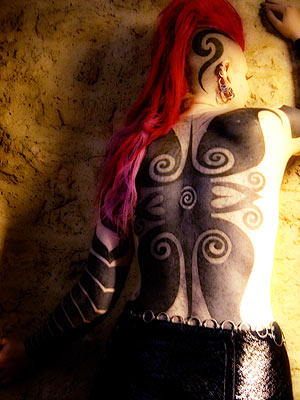
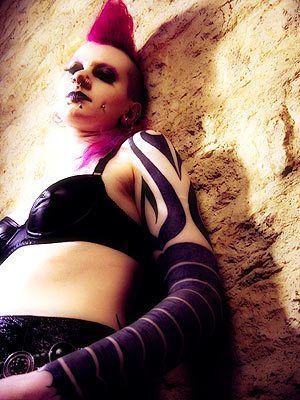
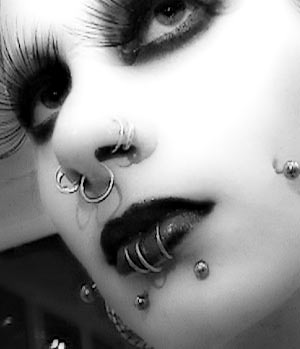
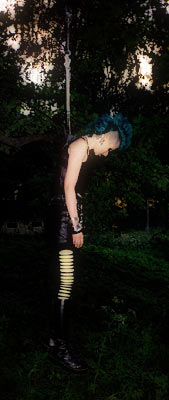
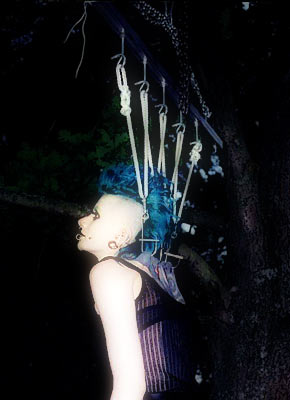

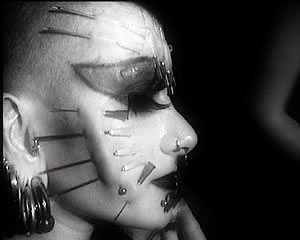
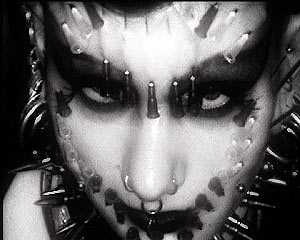
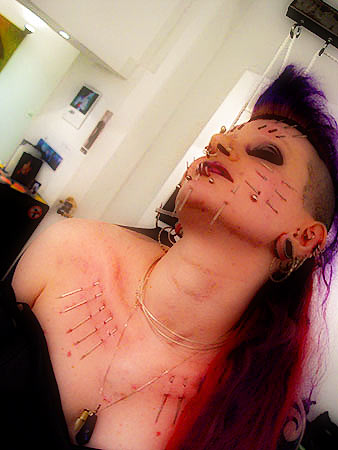
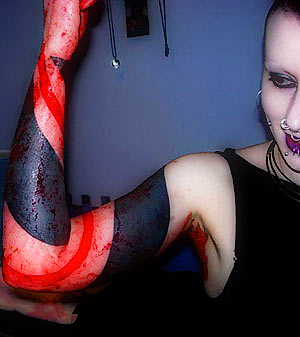
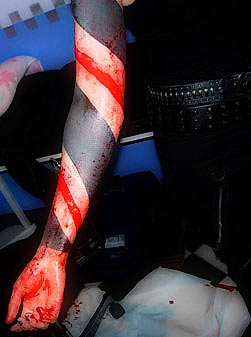
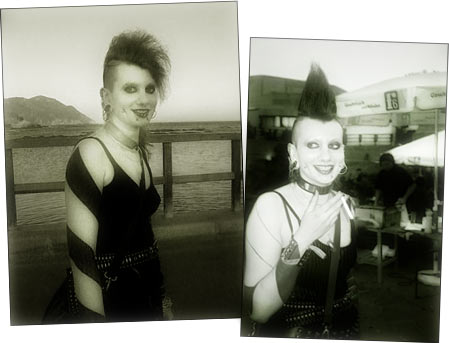

 Kathryn is a 21 year old welder from Melbourne, Australia. She plays the cello and has been getting modified for the past four years.
Kathryn is a 21 year old welder from Melbourne, Australia. She plays the cello and has been getting modified for the past four years. Désirée Fawn Kretschmar (IAM:
Désirée Fawn Kretschmar (IAM: Mike Johnson is a 45 year old self-described Aries/Rat who lives in Charlottesville, Virginia. By day he does layout and design work for a local newspaper, picking up freelance work when he can, from business cards to CD designs for local bands. By night he’s a drummer who plays in alternative, hard rock, punk, or gothic groups, depending on where his head is at the time.
Mike Johnson is a 45 year old self-described Aries/Rat who lives in Charlottesville, Virginia. By day he does layout and design work for a local newspaper, picking up freelance work when he can, from business cards to CD designs for local bands. By night he’s a drummer who plays in alternative, hard rock, punk, or gothic groups, depending on where his head is at the time. Nicole is a preschool teacher from Orlando, Florida who’s been modified for the past five years. She says that road rage is her worst habit, and she strongly dislikes it when people watch her being tattooed.
Nicole is a preschool teacher from Orlando, Florida who’s been modified for the past five years. She says that road rage is her worst habit, and she strongly dislikes it when people watch her being tattooed. Jenn (IAM:
Jenn (IAM: Marisa Terres is from Lompoc, California and is a 21 year old student. She’s interested in contortionism and wants to be able to sit on her own head someday.
Marisa Terres is from Lompoc, California and is a 21 year old student. She’s interested in contortionism and wants to be able to sit on her own head someday. Pops (IAM:
Pops (IAM: Emily (IAM:
Emily (IAM: Sandra O’Conner (IAM:
Sandra O’Conner (IAM: